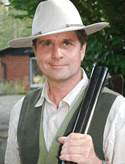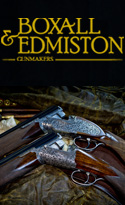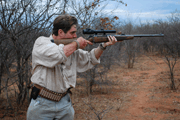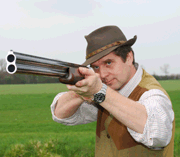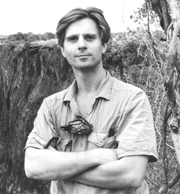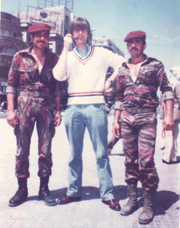The Boxall and Edmiston Story
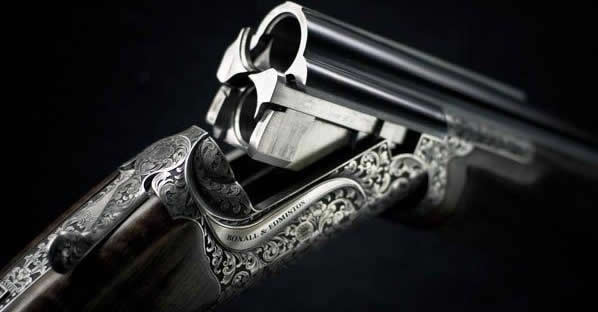
'Yardley Model' O/U shown above (full review here)
I want to look at a new British gunmaker, Boxall & Edmiston, of Upton Magna, Shropshire. Let me hold my hand up at the beginning and note that I have had some recent involvement with the firm developing a new over and under. That gun bears my name, but the young company has an interesting history preceding this exciting project. It is a partnership between development engineer, Peter Boxall, late of Holland & Holland and Jaguar Cars, and James Edmiston who once owned the Stirling Armament Company, famous for its sub-machine guns. It would be fair to say both men are interesting and unusual characters who bring a lot to the gunmaking table. They both manage to be 'old school' whilst demonstrating some very modern thinking.
Peter, a mechanical perfectionist with a bit of artist in him, is the CNC specialist who, under Holland & Holland Technical Director, Russell Wilkin, did much of the design work on the H&H Sporter (notable for being the first predominantly machined British over and under of quality). He had a long interest in guns and shooting (and is a fine shot). James is a long experienced shooter as well, a production specialist, and a savvy business man who has played hard ball in the arms industry and survived. He has a long involvement in the trade – both military and sporting – and a vision of how it might proceed into the future. I think it would be fair to say, in particular, that he saw the writing on the wall for the traditional British sporting gun trade many years ago, an observation which led him to consider alternative, more efficient, models of manufacture.
These came to fruition in the creation of Boxall & Edmiston, a company with traditional, uncompromising, production values, but taking full advantage of the new machining and laser engraving technologies (most of which emanate from the Continent) as well as supporting, indeed, actively promoting, classic 'smoke and file' bench work where deemed necessary in the creation of good quality guns. Innovation and keen pricing are part of the equation, a recognition that many British guns though as desirable as ever are getting just so costly that they beyond the realm of normal mortals.
Sidelock shown above (full review here)
Cutting to the chase, the first gun developed by Boxall & Edmiston was a boxlock side by side. Peter notes of this and the original circumstances of the business partnership: “ James came over to see me in Christmas 2008. We sat down and chatted it all through. There was a natural synergy between us. We decided on an Anson and Deeley design initially because we both thought it was a bit of an unsung hero, not often made to look really elegant. During the talks with James, I was saying things like are you sure you don’t want to make a sidelock first? But we committed at that stage to capturing the classic game gun in a developed boxlock. We carried on designing and looking at tooling for six month and took the keys for our factory at Atcham Business Park in Shrewsbury Shropshire – an old RAF camp – in June 2009.”
So, the B&E was born and the new boxlock with it. Although classic Anson and Deeley in form, it was distinguished by some interesting features. There was a replaceable draw on the bridge of the action table – something more commonly seen in rifles (and which reduces stresses on the hinge pin). Without getting too technical, in most side by sides, effective contact between the lump and the action bar is absent (sometimes because of imperfect manufacture, sometimes by wear). The hinge pin ends up taking the force of the recoil on a small area. The B&E arrangement ensures the recoil force is more equally divided. One would anticipate the gun will stay 'on the face' longer, and, as well as being longer wearing, it might be more easily and efficiently re-jointed should it ever become necessary.
To keep costs within reasonable limits (and today this gun retails from £15,900 in scroll back form and £19,600 with sideplates) barrels were monobloc but with TIG welded invisible joints. With TIG or laser welding it is hard to see any real disadvantage to the monobloc system (although Purdey with their new sporter screw the tubes into the monobloc which would seem another useful refinement). They are still struck up and regulated in the traditional manner, and rust blacked in classical fashion too. The ejector work attached to them, is also worthy of note.
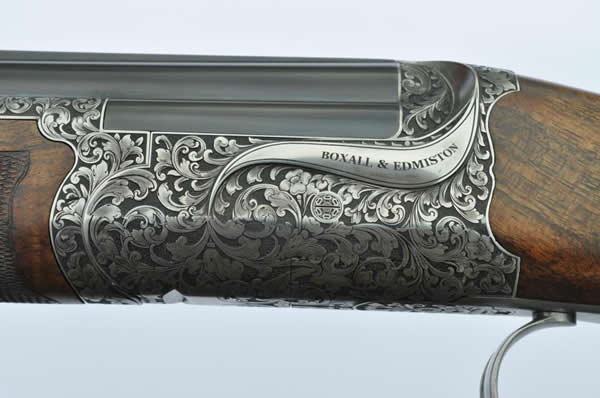
'Yardley Model O/U' shown above (full review here)
Rather than the usual semi-circular leg and narrow guide rod running next to it, this design has diamond cross section in the extractor legs. This eliminates rotation on activation thus dispensing with the need for an extra guide rod too (which is a complication in the traditional design and can be prone to breakage). It is made possible by high tech machining. Because of this new arrangement, other changes are possible. The B&E ejector system also offers increased contact area between the extractor head and the cartridge rim. Cartridges are ejected more positively (as in a good sidelock) and because of the increased contact surfaces, there is reduced wear.
Apart from these features, the gun looks, feels and shoots like a traditional best quality boxlock. The appearance of the metal parts, the overall weight (typically under 7 pounds) and balance, and stock shapes all accord to the British norm. You would be hard pressed to tell it was in any way different to the guns you know (save perhaps if you took a magnify glass to the beautiful laser engraving, when close inspection would reveal all the cuts have vertical sides rather than the angled edges left by a hand powered tool). B & E offered the gun from the start in two forms as noted – with side-plates to increase the canvas for engraving and to put a fraction more weight between the hands – and, with a scalloped back (often a feature of extra finish boxlocks).

The belly of new sideplate model shown left
The Anson and Deeley boxlock has rather fallen out of fashion, but a few makers like Tony White, Westley Richards and now B&E keep it alive. Introduced in the 1870s, it remains one of the greatest of all gun designs. I do much of my shooting these days with an old Webley & Scott boxlock pigeon gun (an option available from Boxall and Edmiston too). And, I also much enjoy a side-plated boxlock Fausti 28 bore. So, I am a convinced boxlock boy. Mr Greener argued for many years that it was the best side by side (but, the truth I suspect is that it may be the most reliable, sidelocks offering a little more weight in the middle and better trigger pulls for their added complexity).
It did not take Boxall & Edmiston long either, before they thought they might develop a side-lock of their own. They were three-quarters of the way there with the side-plated gun. The new project was debuted at the CLA Blenheim 2011. It is a very elegant gun of pinless lock form (which again, extends the canvas for engraving). Full sidelock review here It is, in essence, a Holland & Holland style intercepting safety sear sidelock with Southgate ejectors. It also shoots exceptionally well. I shot the prototype with Drew, Peter Boxall's son, together with a scalloped action boxlock, at the Fennes Shooting Ground in Essex last year. They both performed exceptionally well on skeet and simulated game birds, with the sidelock having the edge on balance and trigger pulls (although the final count was the same with both guns a bird away on 35 engaged). Truly impressive for a gun which looks great and comes in at a price which is half or less the cost of most other English sidelocks.
Before moving on to consider the new over and under, the gun which I have much enjoyed having an input in, it might be useful to note that there seems to be something of a renaissance in British gunmaking at the moment. Boxall & Edmiston seem part of that trend. The picture, though not entirely bright for the broader sporting gun trade, is very different now to the dark days of the 1970s and 80s which saw many traditional businesses in the doldrums, more than a few going to the wall, broken amongst other things by ever cheaper imports.
Those imports taught the trade some lessons though. The Spanish could still survive on cheap labour (though, they are having great difficulty now looking much like Birmingham a generation or two back). The Italians, meantime, revolutionised their gun-making industry by means of high tech machining (something going far beyond the 'interchangeable' principle as developed by British makers a century or more ago). Brought on by geniuses like Ivo Fabbri and Daniel Perazzi, not to mention the mighty Beretta factory, Italian gunmaking led the world. Many took note. Purdey, Holland & Holland, Westley Richards, a clever man in Scotland called David Mckay Brown, another in the US called Tony Galazan, and Batista Rizzini amongst them. In the UK, and evidently inspired by the Italians, John Shirley, Ian Clarke and Ian Medwell became machining maestros, not to mention Pete Boxall himself. The way guns were made changed significantly. Most best guns, for example, went from being predominantly hand-made on the bench to being mainly machine made, or, at the least having many more components made by machine than previously.
It was with all this in mind, that I approached Peter Boxall and James Edmiston in 2010 with the idea of a new over and under. They noted that an over and under had always been part of their business plan, My suggestion was for a low profile trunnion hinging action (like a Wooodward, Perazzi or a Beretta) with Boss locking and leaf springs to power the hammers. The lock work should be fixed. The weights and balances had to be right and the stock shapes were all important. Base price for the gun need to be around the £10,000 mark (as marketed the basic round bar model is now £10,900). I sent Pete a couple of old guns for discussion and he went to work designing a prototype. It quickly took shape because much of it was in his mind from his previous experiences.
We ended up with two prototypes, one I took to a friend in Portugal, Manuel Ricardo, because he offered the facilities for very rapid stock making and excellent on site ranges. We finished the fist stock with a week of non-stop effort. Peter, meantime, stocked the second prototype. Happily, they both ended up looking and feeling very similar. We had both opted for semi-pistol grips and something like a Boss forend. Some slight mechanical changes were made at this point too. A cover plate was incorporated into the action so the cocking rods would not be subject to the ingress of debris. The design of the trigger plate was also improved for purely cosmetic reasons cutting less metal from the belly of the action bar. The production gun now incorporates all this with barrel lengths up to 32” possible. The final stage of development concerns the barrel geometry and we are considering a mechanical trigger. Interest in the new gun has been immense.
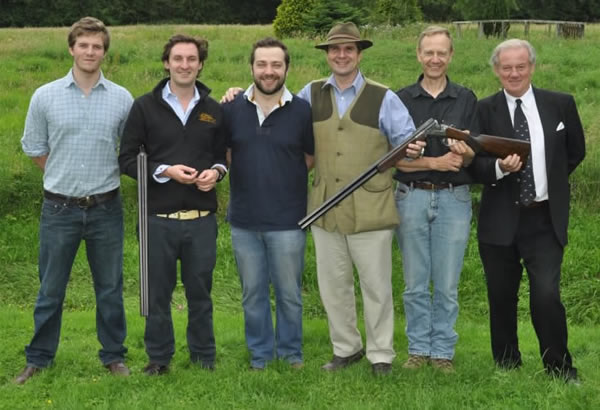
What else for Boxall & Edmiston? Well, a 20 bore is on the cards. It might also have been mentioned that they make many of the v springs for the British trade amongst other parts, and that they are involved in prototype development for others. A double rifle project is also being considered. I might end by noting that although the new guns are made by machine, you would be surprised by just how much hand work they still require, and, time. As far as the engraving is concerned, for example, it is not the product of a few hours work, but typically takes a week or more per gun.
http://www.boxallandedmiston.co.uk/


